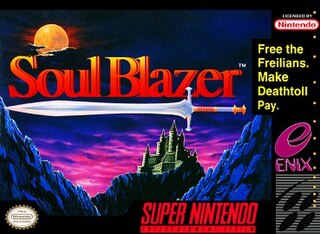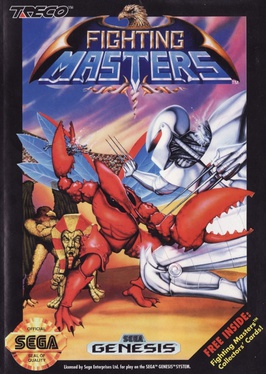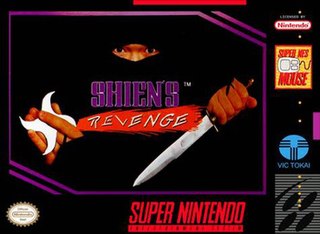
Final Fantasy IV, known as Final Fantasy II for its initial North American release, is a role-playing video game developed and published by Square for the Super Nintendo Entertainment System. Released in 1991, it is the fourth main installment of the Final Fantasy series. The game's story follows Cecil, a dark knight, as he tries to prevent the sorcerer Golbez from seizing powerful crystals and destroying the world. He is joined on this quest by a frequently changing group of allies. Final Fantasy IV introduced innovations that became staples of the Final Fantasy series and role-playing games in general. Its "Active Time Battle" system was used in five subsequent Final Fantasy games, and unlike prior games in the series, IV gave each character their own unchangeable character class.

SimEarth: The Living Planet is a life simulation game, the second designed by Will Wright. and published in 1990 by Maxis. In SimEarth, the player controls the development of a planet. English scientist James Lovelock served as an advisor and his Gaia hypothesis of planet evolution was incorporated into the game. Versions were made for the Macintosh, Atari ST, Amiga, IBM PC, Super Nintendo Entertainment System, Sega CD, and TurboGrafx-16. It was re-released for the Wii Virtual Console. In 1996, several of Maxis' simulation games were re-released under the Maxis Collector Series with greater compatibility with Windows 95 and differing box art, including the addition of Classics beneath the title. SimEarth was re-released in 1997 under the Classics label.

Secret of Mana, originally released in Japan as Seiken Densetsu 2, is a 1993 action role-playing game developed and published by Square for the Super Nintendo Entertainment System. It is the sequel to the 1991 game Seiken Densetsu, released in North America as Final Fantasy Adventure and in Europe as Mystic Quest, and it was the first Seiken Densetsu title to be marketed as part of the Mana series rather than the Final Fantasy series. Set in a high fantasy universe, the game follows three heroes as they attempt to prevent an empire from conquering the world with the power of an ancient flying fortress.

Soul Blazer, released in Japan as Soul Blader, is an action role-playing video game developed by Quintet and published by Enix for the Super Nintendo Entertainment System. It was released in 1992 in Japan and North America, but not released in Europe until 1994.

Terranigma is a 1995 action role-playing game developed by Quintet for the Super Nintendo Entertainment System (SNES), with manga artist Kamui Fujiwara acting as the character designer. The game tells the story of the Earth's resurrection by the hands of a boy named Ark, and its progress from the evolution of life to the present day. The game is considered the third and final entry in an unofficial trilogy of action RPGs created by Quintet, also including Soul Blazer (1992) and Illusion of Gaia (1993).

ActRaiser 2 is a side-scrolling platform game for the Super Nintendo Entertainment System developed by Quintet and published by Enix in 1993.

Illusion of Gaia, known in PAL territories as Illusion of Time, is an action role-playing video game developed by Quintet for the Super Nintendo Entertainment System. The game was released in Japan by Enix in 1993, and in North America and PAL territories by Nintendo in 1994 and 1995. Set in a fantasy reimagining of Earth, the game's plot centers on a boy named Will who is chosen to save the world from an impending disaster. During the course of the game, the player guides Will through levels based on ancient ruins of real-world civilizations and Wonders of the World, such as the Great Pyramid and the Great Wall of China.

SimLife: The Genetic Playground is a video game produced by Maxis in 1992. The concept of the game is to simulate an ecosystem; players may modify the genetics of the plants and animals that inhabit the virtual world. The point of this game is to experiment and create a self-sustaining ecosystem. SimLife was re-released in 1993 as part of the SimClassics Volume 1 compilation, alongside SimCity Classic and SimAnt for PC, Mac and Amiga.

Robotrek, known in Japan as Slapstick, is a role-playing video game (RPG) for the Super Nintendo Entertainment System (SNES). It was developed by Quintet and published by Enix in both Japan and North America in 1994. Set on the fictional planet Quintenix, the game puts the player in control of a budding robotics expert who is the son of a famous inventor.

Axelay is a 1992 scrolling shooter video game developed and published by Konami for the Super Nintendo Entertainment System. Set in the fictional solar system Illis where an alien empire known as "Armada of Annihilation" invades its planets including the Earth-like Corliss (Mother), players take control of the titular D117B space fighter craft as a last resort to stop the alien invasion by recovering its lost weaponry. The gameplay mainly consist of both vertical-scrolling and horizonal-scrolling stages in the same vein as Konami's own Life Force, with players choosing three different weapon-types that increase in number as they progress through the game.
Life simulation games form a subgenre of simulation video games in which the player lives or controls one or more virtual characters. Such a game can revolve around "individuals and relationships, or it could be a simulation of an ecosystem". Other terms include artificial life game and simulated life game (SLG).

Fighting Masters is a 1991 fighting video game developed by Aicom and ALU, and published for the Sega Genesis in Japan and later in North America by Treco. In the game, players assume the role of a hero to fight against an assortment of opponents on an apocalyptic setting to face against an entity known as Lord Valgasu. Co-directed by Hajime Kusano and Ramō Kobayashi, the title was created by some of the same team that would later work on various projects at Almanic Corporation such as E.V.O.: Search for Eden. It was met with mixed reception from critics since its release.

Wonder Project J is a 1994 life simulation video game developed by Almanic Corporation and published by Enix for the Super Famicom. In the game, players take care of a boy Gijin (robot) created by Dr. Geppetto named Pino. Directed by Takashi Yoneda, the title was created by most of the same personnel that worked on previous projects at Almanic such as E.V.O.: Search for Eden. It was met with positive reception from critics and sold over 1.3 million copies in Japan, making it one of the best-selling Super Famicom games. A sequel, Wonder Project J2, was released in 1996 for the Nintendo 64.

Mazin Saga: Mutant Fighter is a 1993 hybrid beat 'em up/fighting video game developed by Almanic Corporation, in conjunction with ALU and Team "Saga", and published by Vic Tokai for the Sega Genesis in North American and later in Japan and Europe by Sega. Based upon Go Nagai's MazinSaga mecha manga, which is considered a combination of Nagai's Mazinger and Devilman franchises, players assume the role of Koji Kabuto wielding the Mazinger Z armor to fight against powerful 'Bio Beasts' led by God Kaiser Hell. Co-directed by Satsuki Mizuno, Takashi Yoneda and "Tommy Bon Bon", the title was created by most of the same team that worked on previous projects at Almanic such as E.V.O.: Search for Eden. It was met with mostly positive reception from critics since its release.

Nanatsu Kaze no Shima Monogatari is a 1997 graphic adventure video game developed by Givro Corporation and published by Enix for the Sega Saturn. The last game to be created by Givro prior to their dissolution in 1998, the title takes place on a mysterious island, as players assume the role of a dragon named Gaūpu to meet various creatures inhabiting the location while harnessing seven legendary winds to overcome obstacles. It received positive reception from critics and reviewers alike, with high praise given towards its hand-drawn visuals.
Givro Corporation was a Japanese video game development company founded in 1989 in Tokyo, Japan by Takashi Yoneda, who was previously employed by Technos Japan and Enix. The company was originally established under the name Almanic Corporation, which it operated under for a few years before changing its corporate name in 1995. Givro would go on to produce games for home consoles such as the Super Nintendo Entertainment System, Sega Genesis, 32X, Nintendo 64 and Sega Saturn. Givro released their final game in late 1997 and quietly dissolved at the end of the following year.

Shien's Revenge is a 1994 rail shooter video game developed by Almanic Corporation and originally published by Dynamic Planning for the Super Nintendo Entertainment System in Japan and later in North America by Vic Tokai. In the game, players assume the role of the titular ninja to fight against monsters coming from a time portal in order to face against an entity known as Undertaker and rescue his companion Aska. Co-designed by Takashi Shichijo and mangaka Go Nagai, the title was created by most of the same team that worked on previous projects at Almanic such as E.V.O.: Search for Eden. It was met with mixed reception from critics since its release.

Gradius III is a 1989 scrolling shooter video game developed and published by Konami, originally released for the arcades in Japan and other parts of Asia on December 11, 1989. It is the third game in the Gradius series. The game was ported to the Super Nintendo Entertainment System in Japan in 1990 and North America in 1991, and served as a launch title for the system in North America. The arcade version would never see the light of day in the West until it was included alongside Gradius IV in a two-in-one compilation for the PlayStation 2 and in the Gradius Collection for the PlayStation Portable.


















